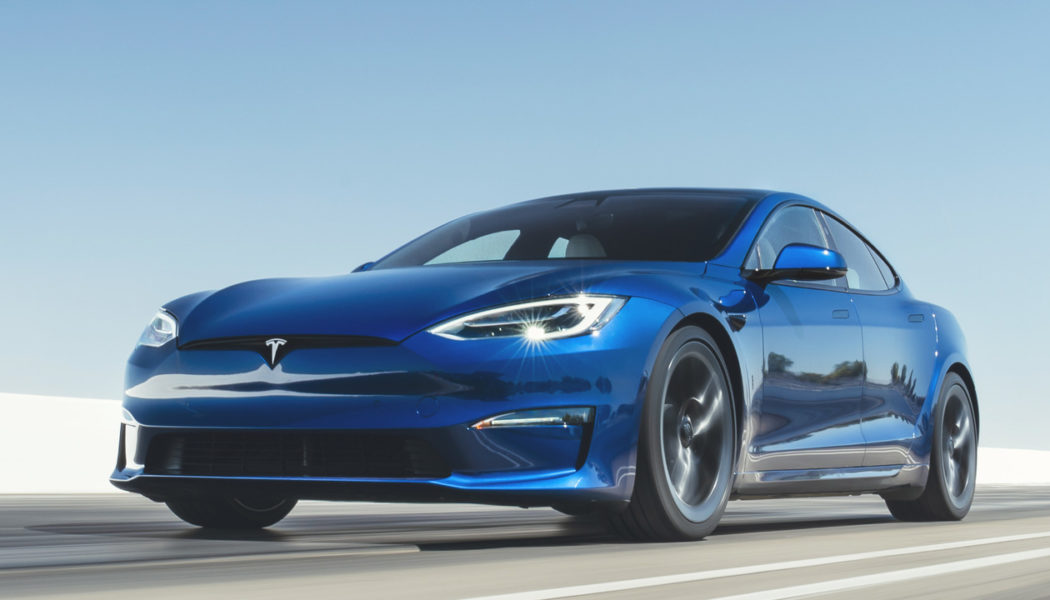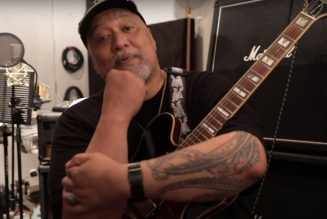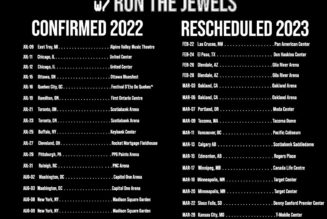We can largely thank Tesla for making electric vehicles exciting. From the original Roadster to the more practical and mass-market Model 3, Tesla hasn’t missed a beat in creating vehicles that are quick, nimble, and technologically advanced. While other automakers will be flooding the market with high-performance EVs in the coming years, we’ll always appreciate Tesla for beginning the charge. And though there’s no shortage of turmoil at the company these days, Tesla remains committed to high performance, promising a host of new vehicles including the Model Y SUV and next-gen Roadster. To see how the carmaker has evolved over the last decade, keep reading for a list of all the Tesla vehicles we’ve ever tested.
2010 Tesla Roadster Sport
0-60: 3.7 seconds
¼ mile: 12.6 seconds at 102.6 mph
Figure eight: 24.6 seconds at 0.81 g (avg)
60-0: 113 feet
Tesla nailed it with its first product, the Roadster. In 2009, we clocked this sinewy sports car hitting 60 mph in an impressive 3.7 seconds. The Sport model we tested produced the same 288 hp as the standard Roadster but at 600 fewer revs (4,400 rpm) and 295 lb-ft of torque, up from 273 lb-ft. The feeling behind the wheel was almost otherworldly. “It’s such an unnatural thrust that it actually brings to mind that hokey Star Trek star-smear of warp-speed,” we wrote in a First Test. “The quick, linear accumulation of velocity makes you smile and hold on, shake your head, and eventually learn to carve unimaginable moves through traffic that’s populated by completely flat-footed internal combustion cars.” Predictably, the performance came with a high price tag of $130,000.
We can’t wait to test the new 2020 Tesla Roadster, which the automaker claims will be able to hit 60 mph in 1.9 seconds.
2012 Tesla Model S P85
0-60: 3.9 seconds
¼ mile: 12.5 seconds at 110.9 mph
Figure eight: 25.3 seconds at 0.70 g (avg)
60-0: 105 feet
The next time we tested a Tesla, it was Elon Musk’s personal Model S. Tesla had just introduced the electric luxury sedan, and this performance version made 416 hp and 443 lb-ft of torque. Weighing almost 2,000 pounds more than the Roadster we tested, this car took 3.9 seconds to hit 60 mph. We managed to travel from Fontana on the eastern edge of the L.A. basin to San Diego and all the way back on one charge, pushing the car’s 265-mile range to the limit.
2013 Tesla Model S P85
0-60: 4.0 seconds
¼ mile: 12.4 seconds at 112.5 mph
Figure eight: 25.6 at 0.77 g (avg)
60-0: 113 feet
The Model S was a contender for MotorTrend’s Car of the Year award—and it won. Like our last Model S tester, this model had the performance bits that helped it make 416 hp.
The vote was unanimous among the 11 judges. “The mere fact the Tesla Model S exists at all is a testament to innovation and entrepreneurship, the very qualities that once made the American automobile industry the largest, richest, and most powerful in the world,” we wrote. “America can still make things. Great things.”
2013 Tesla Model S
0-60: 5.0 seconds
¼ mile: 13.2 seconds at 110.9 mph
Figure eight: 25.7 seconds at 0.76 g (avg)
60-0: 124 feet
During our Car of the Year evaluation, we also tested a less powerful version of the Model S. It still had the biggest 85-kilowatt-hour lithium-ion battery option, but the powertrain’s output was limited to 362 hp and 325 lb-ft of torque. The sedan hit 60 mph in 5.0 seconds, making it a full second slower than the performance models we had tested.
2013 Tesla Model S P85+ Long Term
0-60: 4.0 seconds
¼ mile: 12.7 seconds at 107.8 mph
Figure eight: 25.3 seconds at 0.74 g (avg)
60-0: 108 feet
After the Model S won our Car of the Year award, we drove one for more than a year to get a better idea of how it performs over the long run. We came away impressed, despite the model getting a new power unit when technicians noticed a clicking sound in the single-speed reduction gears—it proved an easy swap-out. Over the course of 38,000 miles, the car’s battery experienced little degradation.
2014 Tesla Model S P85+
0-60: 3.9 seconds
¼ mile: 12.5 seconds at 108.4 mph
Figure eight: 24.8 seconds at 0.80 g (avg)
60-0: 102 feet
In 2014, we pitted a Model S against the BMW i8 in a comparison test. Although the i8 proved more nimble, the Model S took the crown for its impressive power, everyday livability, and excellent efficiency.
2015 Tesla Model S P85D
0-60: 3.1 seconds
¼ mile: 11.6 seconds at 115.2 mph
Figure eight: 25.0 seconds at 0.77 g (avg)
60-0: 113 feet
By this point, Tesla had made significant updates to the Model S, including improved seats and upgraded powertrains. Thus, Tesla’s new P85D model boasted a significant power increase over previous Model S sedans. It had a new dual-motor setup—one motor at the front and one at the back—good for a combined 691 hp and 687 lb-ft of torque. We were pleased with the upgrades, noting in our First Test: “The torque impacts your body with the violence of facing the wrong way on the train tracks when the whistle blows.”
2015 Tesla Model S P85D
0-60: 3.2 seconds
¼ mile: 11.7 seconds at 113.7 mph
Figure eight: 25.2 seconds at 0.79 g (avg)
60-0: 104 feet
2015 Tesla Model S P90D Ludicrous
0-60: 2.6 seconds
¼ mile: 10.9 seconds at 122.7 mph
Figure eight: 24.7 at 0.81 g (avg)
60-0: 109 feet
Now, Tesla was making a version of the Model S with an insane 762 hp and 713 lb-ft of torque. This combined output comes courtesy of a more potent version of the new all-wheel-drive, dual-motor setup. In our tests, the Model S with the Ludicrous update zipped to 60 mph in 2.6 seconds, making it the quickest four-door on the market at the time. This time was even good enough to beat top sports cars. It was quicker to 60 mph than the Nissan GT-R, Lamborghini Aventador, and Bugatti Veyron, and it was tied with the McLaren P1.
2016 Tesla Model X P90D Ludicrous
0-60: 3.2 seconds
¼ mile: 11.7 seconds at 116.0 mph
Figure eight: 25.1 seconds at 0.78 g (avg)
60-0: 106 feet
Tesla took the Ludicrous magic of the top Model S and repackaged it in SUV form. The Model X, known for its falcon-wing doors, is ridiculously quick when equipped with a dual-motor powertrain making a total of 532 hp and 713 lb-ft of torque. Its 5,516-pound curb weight didn’t hinder its performance; the SUV cosseted drivers with excellent ride quality and cornering ability, plus very solid braking performance. It became the quickest SUV we had ever tested at the time, and it was even 0.2 second quicker than a Ferrari Enzo to 60 mph.
2016 Tesla Model X 75D
0-60: 5.5 seconds
¼ mile: 14.1 seconds at 100.6 mph
Figure eight: 26.7 seconds at 0.70 g (avg)
60-0: 113 feet
Without the dual-motor setup of our previous tester, this version of the Model X had more modest performance. The 328-hp SUV hit 60 mph in 5.5 seconds, putting it on par with the Jaguar F-Pace S AWD. In a review, we noted you get 90 percent of the adventure of the top P90D model for more than $40,000 less.
2016 Tesla Model S 60
0-60: 5.0 seconds
¼ mile: 13.6 seconds at 103.5 mph
Figure eight: 26.5 seconds at 0.70 g (avg)
60-0: 121 feet
Finally, it was time to test the “budget” version of the Model S sedan. Making 315 hp, this sedan managed to hit 60 mph in 5.0 seconds, which was still quick compared with many other EVs on the market. Range was limited to 200 miles, but buyers could pay for a software upgrade that unlocked an extra 40 miles of range. It had a bit more body roll than higher-trim Model S sedans equipped with stickier tires and an air suspension. But for less than $70,000 before tax credits, you were still getting a technological marvel with a solid ride and great steering.
2017 Tesla Model S P100D (Ludicrous+)
0-60: 2.3 seconds
¼ mile: 10.5 seconds at 125.0 mph
Figure eight: 24.6 seconds at 0.82 g (avg)
60-0: 109 feet
Tesla outdid itself again. The Tesla Model S P100D featured a new 100-kW-hr battery pack with enough juice to propel itself to 60 mph in 2.28 seconds. At the time, it was the quickest production car MotorTrend had ever tested. P100D models could travel 315 miles on a single charge.
2017 Tesla Model 3 Long Range
0-60: 4.8 seconds
¼ mile: 13.4 seconds at 104.9 mph
Figure eight: 25.7 seconds at 0.74 g (avg)
60-0: 119 feet
The Model 3 was “make it or break it” for the automaker. It was a test to see if Tesla could build affordable cars with enough range to serve as someone’s one and only vehicle. So far, it has been a big sales success. When it arrived on the scene, Tesla’s small sedan proved more capable in many ways than a segment favorite, the BMW 330i. For instance, with a 0-60 time of 4.8 seconds, it was 0.7 second quicker to 60 mph. This rear-drive model made 271 hp and 307 lb-ft of torque.
2018 Tesla Model 3 Dual Motor Performance
0-60: 3.2 seconds
¼ mile: 11.8 seconds at 115.2 mph
Figure eight: 24.3 seconds at 0.84 g (avg)
60-0: 99 feet
This Model 3 variant is far from entry level. Packing 450 hp and 471 lb-ft of torque from a dual-motor, all-wheel-drive powertrain, this small sedan made it to 60 mph in 3.2 seconds. Just as notable, it managed to brake from 60 mph in 99 feet, putting it on par with the Alfa Romeo Giulia Quadrifoglio.
2018 Tesla Model 3 Dual Motor Long Range
0-60: 4.0 seconds
¼ mile: 12.5 seconds at 113.1 mph
Figure eight: 24.9 seconds at 0.78 g (avg)
60-0: 113 feet
This model combined the best from the two-motor Model 3 with the longer-range model. Most consumers will not be wanting for power. With a total of 346 hp and 376 lb-ft of torque from its two motors, this sedan hit 60 mph in 4.0 seconds. That time put it in good company with the Ford Mustang GT, Chevrolet Camaro SS, and Dodge Charger and Challenger Hellcats.
2020 Tesla Model Y Dual Motor Long Range
0-60: 4.1 seconds
¼ mile: 12.4 seconds at 114.8 mph
Figure eight: 25.2 seconds at 0.75 g (avg)
60-0: 118 feet
The Tesla Model Y is to the Model X what the Model 3 is to the Model S, and we finally tested the electric automaker’s entry-level SUV in late 2020. Mind you, we’d already driven both a Model Y Long Range and a Model Y Performance beforehand, however, the pandemic prevented us from putting both Tesla SUVs through our usual array of performance testing. Unfortunately, we’ve only managed to put the less powerful Model Y Long Range through our testing regimen. While the 456-hp Performance is surely the more dynamically capable Model Y option, the 384-hp Long Range certainly didn’t disappoint. In fact, the 295-pound heavier Model Y Long Range hit the mile-a-minute mark just 0.1 second behind that of the last Model 3 Long Range we tested. Even crazier? It bested the lighter and equally powerful Model 3’s quarter-mile time by 0.1 second and its trap speed by 1.7 mph.
2021.5 Tesla Model S Plaid
0-60: 2.1 seconds
¼ mile: 9.3 seconds at 152.2 mph*
Figure eight: 23.5 seconds at 0.90 g (avg)
60-0: 104 feet
Tesla’s 1,020-hp Model S Plaid didn’t let us down when we took it to the track. While the sedan’s 2.1-second trot to 60 mph came a bit short of Tesla’s sub-2.0-second claim, it still managed to earn the title of quickest production vehicle tested by MotorTrend—beating out the prior titleholder, a 2017 Model S P100D. Although we weren’t able to run the Model S Plaid through the quarter mile, our data suggest this EV would have crossed the 1,320-foot mark in a mere 9.3 seconds at 152.2 mph. Wow!










